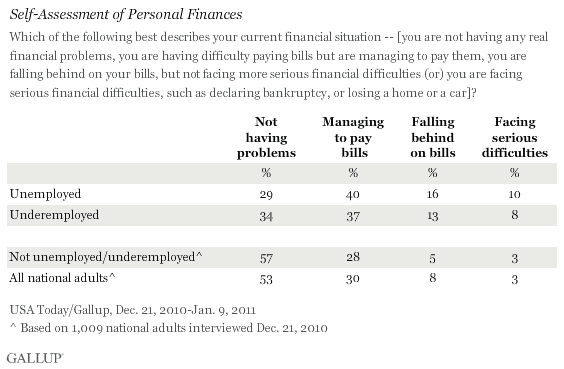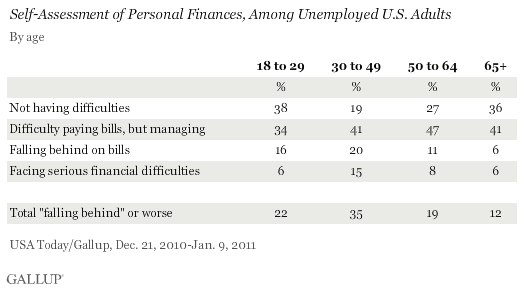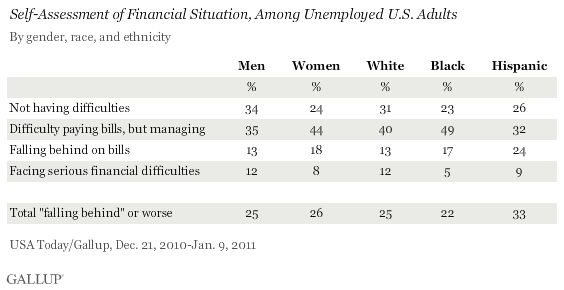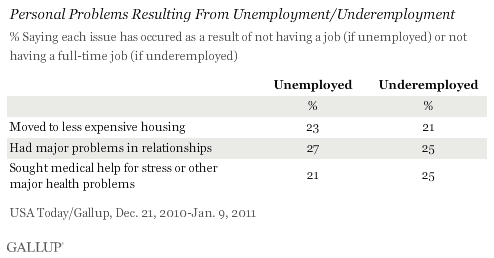PRINCETON, NJ -- About one in four unemployed adults in the United States today, 26%, reports they are either falling behind on their bills or facing more serious financial difficulties such as bankruptcy or foreclosure. This compares with 21% of underemployed Americans and 8% of adults who are neither unemployed nor underemployed.

Although most unemployed Americans are not sinking financially, relatively few are worry free: fewer than 3 in 10 say they are having no difficulty whatsoever meeting expenses. An additional 40% are having trouble paying their bills, but managing to do so.
These results are based on a USA Today/Gallup poll conducted as part of Gallup Daily tracking between Dec. 21, 2010 and Jan. 9, 2011. The USA Today/Gallup survey defines unemployed Americans as adults aged 18 and older who are currently out of work but say they are able to work and are actively looking. The unemployed group also includes out-of-work adults who are not currently looking for a job, but who plan to look in the future. The latter constitute so-called "discouraged workers" who are commonly considered out of the workforce and therefore not included in standard government or Gallup unemployment figures. Underemployed Americans are those working part time, but who would like to work full time.
Underemployed Americans are only slightly better situated than the unemployed, with 34% reporting no financial problems. Unemployed and underemployed adults, however, are faring far worse than other Americans.
Nearly 6 in 10 U.S. adults who are neither unemployed nor underemployed -- essentially all adults employed full time or employed part time but not wanting full-time work, retirees, and those not in the workforce -- say they are not having financial difficulties.
Financial Risk Greater for 30- to 40-Somethings
Being unemployed appears to carry greater financial risks for adults aged 30 to 49 than for those younger or older. More than one-third of unemployed Americans in this age group, compared with 22% of younger unemployed adults, 19% of those aged 50 to 64, and 12% of seniors, indicate they are either falling behind on their bills or experiencing more serious financial problems.
Although the reason for this pattern is unclear, it could reflect that 30- to 49-year-olds are old enough to have acquired significant expenses such as mortgages, car payments, and children, but are not old enough to have accumulated the financial reserves necessary to carry them in bad times.

While unemployed men are more likely than unemployed women to report experiencing no financial problems, they are slightly more likely to be facing serious financial problems. This U-shaped pattern in reported financial security is also seen among whites relative to blacks and Hispanics.

Most Unemployed Americans Have Avoided Housing, Relationship, Stress Issues
The USA Today/Gallup survey also asked unemployed and underemployed Americans whether they have experienced each of three kinds of problems often associated with lack of employment: having to find less expensive housing, encountering major problems in relationships with a spouse or other close family member, and seeking medical help for stress or other health problems resulting from joblessness.
The percentages of unemployed vs. underemployed Americans experiencing each of these problems are generally similar, ranging from 21% to 27%. Among the unemployed, encountering major problems in relationships with a spouse or other close family member is the most common occurrence, experienced by 27%. However, the majority of unemployed -- as well as underemployed -- Americans say they have not experienced each of these problems.

Bottom Line
Fewer than 3 in 10 unemployed Americans (29%) are fortunate to report they are having no difficulty meeting their expenses, contrasted with 57% of Americans who are neither unemployed nor underemployed. Many of the unemployed are struggling to make ends meet, while more than one-quarter are in the untenable situation of falling behind on their bills; this includes 10% who are facing serious financial consequences such as bankruptcy or losing a home or car. At the same time, most unemployed and underemployed Americans have not experienced severe consequences such as having to move or seeking medical help for stress or other major health problems.
Underemployed Americans -- those working part time but wanting full time work -- are only marginally better off financially than the unemployed, both in terms of their finances and their experience with significant personal problems resulting from lack of work.
Survey Methods
Unemployed and underemployed results are based on telephone interviews conducted as part of Gallup Daily tracking from Dec. 21, 2010-Jan. 9, 2011, with a random sample of 15,120 adults, aged 18 and older, living in all 50 U.S. states and the District of Columbia, selected using random-digit-dial sampling.
For results based on the subgroup of 1,145 unemployed Americans, one can say with 95% confidence that the maximum margin of sampling error is ±4 percentage points. Unemployed Americans are defined as not currently working and either actively looking for work or not actively looking for work now, but saying they want to work 30 or more hours per week and saying they plan to actively look for work in the future.
For results based on the subgroup of 675 underemployed Americans, one can say with 95% confidence that the maximum margin of sampling error is ±5 percentage points. Underemployed Americans are defined as currently working a part-time job but wanting to work a full-time job.
The national adult and non-unemployed/underemployed results reported for comparison in this article are based on telephone interviews conducted as part of Gallup Daily tracking on Dec. 21, 2010, with a random sample of 1,009 adults, aged 18 and older, living in all 50 U.S. states and the District of Columbia, selected using random-digit-dial sampling.
For results based on the total sample, one can say with 95% confidence that the maximum margin of sampling error is ±4 percentage points.
Interviews are conducted with respondents on landline telephones and cellular phones, with interviews conducted in Spanish for respondents who are primarily Spanish-speaking. Each daily sample includes a minimum quota of 200 cell phone respondents and 800 landline respondents, with additional minimum quotas among landline respondents for gender within region. Landline respondents are chosen at random within each household on the basis of which member had the most recent birthday.
Samples are weighted by gender, age, race, Hispanic ethnicity, education, region, adults in the household, cell phone-only status, cell phone-mostly status, and phone lines. Demographic weighting targets are based on the March 2010 Current Population Survey figures for the aged 18 and older non-institutionalized population living in U.S. telephone households. All reported margins of sampling error include the computed design effects for weighting and sample design.
In addition to sampling error, question wording and practical difficulties in conducting surveys can introduce error or bias into the findings of public opinion polls.
View methodology, full question results, and trend data.
For more details on Gallup's polling methodology, visit https://www.gallup.com/.
